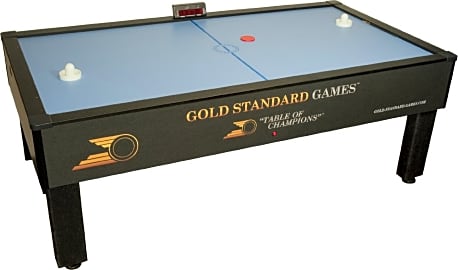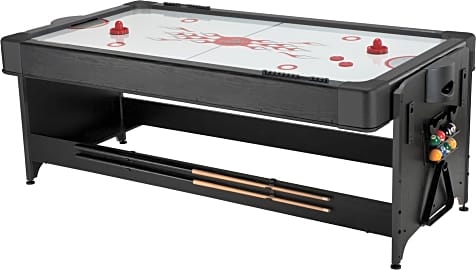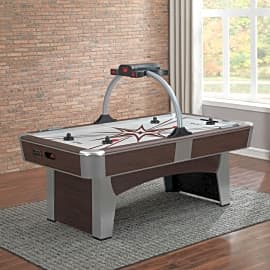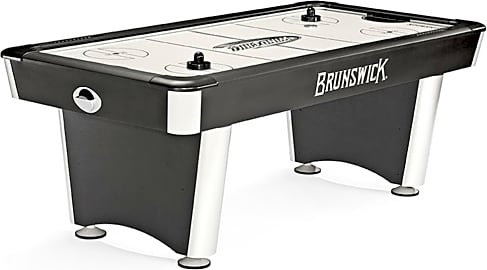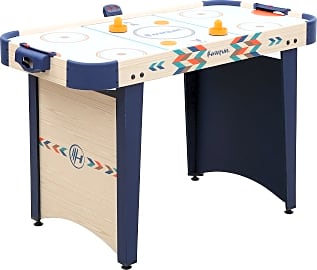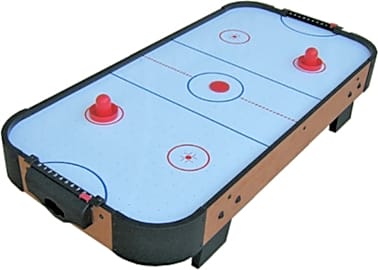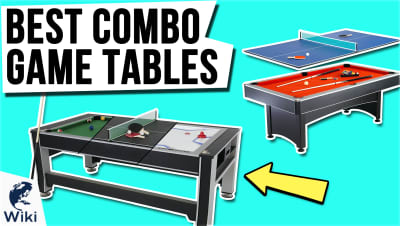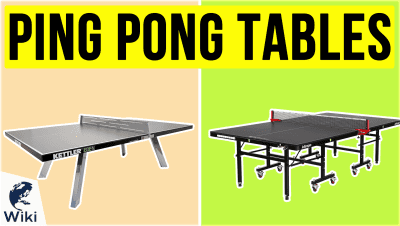The 10 Best Air Hockey Tables

This wiki has been updated 39 times since it was first published in February of 2015. The best air hockey tables deliver consistent air pressure across the whole surface, keep the puck in play, do not scratch easily, stay in place while being used, and help you keep track of the score. We've reviewed budget-priced models good for young children, mid-range options suitable for any home, and high-end offerings ideal for dedicated enthusiasts and commercial establishments. When users buy our independently chosen editorial choices, we may earn commissions to help fund the Wiki.
Editor's Notes
December 09, 2020:
Air hockey is a great way to provide hours of entertainment to friends and family members. And, since games can get pretty intense, it is important to choose a sturdy model, especially if it is going to be used by adults. Those that are intended for kids don't need to be quite as strong, since they won't be hitting the pucks as hard, and they generally won't be putting as much weight on the table either. We have included models ideal for both applications, as well as those perfect for home and business use.
When it comes to home use, we think the Atomic Northport 3-in-1 stands out as one of the top options, specifically for those who don't have a dedicated game room or a lot of extra space in their house. Along with being an air hockey table, it can convert into a ping pong table. However, one if its best features is that it also converts into a rather attractive dining room table. The Fat Cat Pockey is another combo game table that helps you make the most of your available floor space, however, this offers ping pong and billiards, rather than a place to eat.
For the youngsters in the house, we recommend the Harvil 4-Foot if you want a standalone model, and either the Playcraft Sport 40-Inch or Sport Squad HX40 for tabletop use. Of these, the Harvil 4-Foot offers the most powerful air flow, and, as a result, the best action, however the Playcraft Sport 40-Inch and Sport Squad HX40 are more affordable and will require less space in a home since they can be more easily hidden away for storage when not in use.
For commercial settings, the Gold Standard Pro Elite and Valley-Dynamo Fire Storm immediately stand out. The former is endorsed by several air hockey champions and has a professional-quality build with a no-nonsense look that makes it ideal for tournaments and competitive play. On the other hand, the latter is an eye-catching model that would fit right into a trendy arcade setting. It is complete with flashing lights and sounds, glowing playing surface accents, and an overhead digital scorekeeper. It's also equipped with a coin slot.
December 17, 2019:
Air hockey can offer nearly endless entertainment, so long as the table is well-built. The most important component to any air hockey table is its air flow, of course, and that has to do with the power of its blower and the size, spacing, and consistency of the holes cut in its surface. That's because the air actually lifts the puck ever-so-slightly off the surface of the table, allowing it to glide with such efficiency. A weak blower, inconsistently drilled or constricted holes, and you've got no game. That's the main reason we said goodbye to the Triumph Lumen X from our last ranking, as its blower, while strong enough to create a good cushion of air, had durability issues.
New to our list are the Valley-Dynamo Fire Storm, which is a full-scale commercial model capable of taking currency in exchange for games, and the Brunswick Windchill, which comes from a recognizable name in parlor games, and that offers a lightweight, reliable build quality. And for the game room that spares no expense, we added a model from luxury game designer 11 Ravens to the list in our special honors section, which is just one of several eye-catching and thoughtfully engineered designs available in the low-five-figures range.
Special Honors
11 Ravens Arclight This is just one of 13 outstanding options from a custom table designer located in California. All the products are made in the US, and this particular version features a teal and white gradient that immediately feels like winter. It has an exceptionally strong blower that provides a soft, effective air cushion, and everything about its components feels top notch. Unfortunately, just about all the games the company makes are somewhat prohibitively expensive. 11ravens.com
What To Think About Before Buying An Air Hockey Table
Even if you're only playing occasionally, you might still want to splash out some cash on a table that will look good in your man cave or spare room.
There are couple of questions you should ask yourself before you decide which air hockey table to purchase. First consider who will be playing on the table. If you own a bar, or you run a youth club — that is, if you're buying an air hockey table for use by anyone outside your immediate household — you should probably be looking for an arcade style table. If it's for your kids, though, you might be happy with a smaller, more affordable model, or even a tabletop version. If you go this route, it can still make for more engaging gameplay as long as you purchase one with cool features like sound effects and an electronic scoreboard.
Next, you need to ask yourself how seriously the intended players take the game. You don't need to be an aspiring Colin Cummings to want a top quality, arcade style table. Even if you're only playing occasionally, you might still want to splash out some cash on a table that will look good in your man cave or spare room. If you are particularly competitive and in search of a premium gaming experience, then you'll want to look for a product that has a powerful motor, a durable surface, and well-designed rails.
Be aware that some air hockey tables marketed as kid's toys don't actually have the machinery to provide a cushion of air on the table, relying instead on a slick surface. That's probably fine for young kids, but if you're used to playing in an arcade, you're likely to find the experience lackluster at best. If you think you or your kids will easily get bored of air hockey and might want to periodically play foosball, table tennis, or pool instead, then you might want to purchase a combo game table.
Finally, you should consider how much space you have for your table. If you are tight on space, it makes sense to buy a tabletop version that you can store in the closet when not in use, unless of course you plan on throwing out some furniture. After all, why waste time sitting on a couch when you can be playing an invigorating game of air hockey?
If you don't have a lot of space, but feel like a tabletop version just won't be up to your standards, you can buy a foldaway table or a lightweight model that can be moved out of the way when not in use. These are usually a bit more sturdy and have a larger playing surface than most tabletop models.
If space isn't an issue and you have determined that you and your friends are up for some serious, competition-level gaming, then a full-sized model is what you need.
How Do Air Hockey Tables Work, Anyway?
The United States Air Hockey Association is surprisingly strict about which air hockey tables are acceptable for official play. Not only must they meet stringent size regulations, but they must also be one of the models sanctioned by the association. They don't just have rules regarding what type of table players can use, but also what gaming accessories are acceptable. We're a little less fussy than that, but we will say this: it's not a real air hockey table without air. The cushion of air is vital to a true air hockey experience, after all. It is this that allows the puck to glide across the surface as if it was sliding across ice.
The cushion of air is vital to a true air hockey experience, after all.
To create this cushion of air, manufacturers put a motor and fan somewhere inside of the table. Once the motor is turned on, the fan forces jets of air through thousands of tiny pin holes in the gaming surface. This creates enough pressure to slightly lift the puck off the surface, much like how a hovercraft works.
These are the basic components of any air hockey table. As the models get more complex, they will incorporate more technology. For example, tables that feature an electronic scoreboard will have a sensor somewhere inside of the goal that registers when a puck passes through. Some versions may have glowing pucks that light up each time they are hit, or lights integrated into the side rails that illuminate the playing surface.
A Brief History Of Air Hockey
Air hockey was first invented by three employees of the Brunswick Billiards company: Brad Baldwin, Phil Crossman, and Bob Kendrick. In 1969, they had the idea for a frictionless gaming surface, though they didn't know exactly what kind of game it would be best suited to. This resulted in the project stagnating for a couple of years with no real direction. Luckily for air hockey aficionados, they happened to cross paths with a man who had the perfect vision of how to use a frictionless gaming surface; retired pro hockey defencemen Bob Lemieux. Once he hopped on board, he helped focus the project towards creating a modified version of ice hockey, rightly assuming that the air table the Brunswick employees were developing would replicate the way a puck effortlessly glided across ice at high speeds. And so, air hockey was born. For reasons that are unclear, the original patent only included the names of three of the four men.
The game was instantly a smash hit, proving to be extremely popular, as well as profitable for the company. In 1973, a group of players in Houston formed the first air hockey association. Originally known as the Houston Air Hockey Association, it quickly changed its name to the Texas Air Hockey Association. Due to a growing interest in large scale official national tournaments, J. Phillip Arnold established the United States Air Hockey Association in 1975. The association then went on to establish official tournament rules and started to actively promote the sport. Since 1975, the USAA has held over 30 annual tournaments, either domestically or internationally, and crowned more than 10 champions.
In 2015, another governing body arose, the Air Hockey Players Association, and started holding their own international tournaments. Currently the USAA and AHPA share many rules, and high-level players often compete in both associations, though the organizations are run independently of one another.


